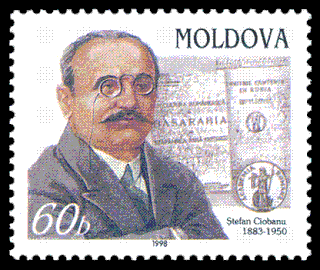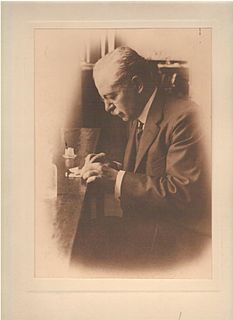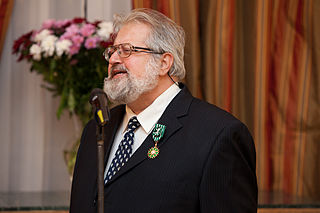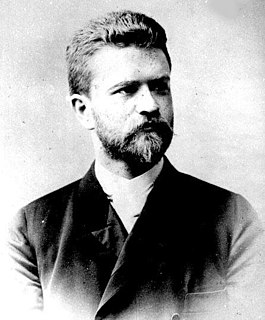
Politehnica University of Bucharest is a technical university in Bucharest, Romania. 200 years of activity have been celebrated lately, as the university was founded in 1818. Politehnica University is classified by the Ministry of Education as an advanced research and education university.

Ștefan Odobleja was a Romanian physician and scientist, considered in Romania to be one of the precursors of cybernetics and artificial intelligence.
Alexandru Ghika was a Romanian mathematician, founder of the Romanian school of functional analysis.
Liviu Constantinescu was a Romanian geophysicist, professor of geophysics, member of the Romanian Academy. He was the cofounder, together with Sabba S. Ștefănescu, of the Romanian school of geophysics.
Sabba S. Ștefănescu was a Romanian geophysicist, professor of geophysics, member of the Romanian Academy. He was the cofounder, together with Liviu Constantinescu, of the Romanian school of geophysics.

Pantelimon "Pan" Halippa was a Bessarabian and later Romanian journalist and politician. One of the most important promoters of Romanian nationalism in Bessarabia and of this province's union with Romania, he was president of Sfatul Țării, which voted union in 1918. He then occupied ministerial posts in several governments, following which he underwent political persecution at the hands of the Communist régime and was later incarcerated in Sighet prison.
Camil Bujor Mureşanu was a Romanian historian, professor, author, and translator.

Horia Hulubei was a Romanian nuclear physicist, known for his contributions to the development of X-ray spectroscopy.

Andrei Eșanu is a historian, writer and researcher from the Republic of Moldova. He is a member of the Commission for the Study of the Communist Dictatorship in Moldova. He is part of the Academy of Sciences of Moldova, and was elected an honorary member of the Romanian Academy in 2011.

Ștefan Ciobanu was a Romanian historian and academician, author of some important works about ancient Romanian literature, Romanian culture in Basarabia under Russian occupation, Bessarabian demography, fervent advocate of the introduction of the Romanian language in the schools of Bessarabia, vice-president of the Romanian Academy between 1944–1948. He served as Minister of Education (1917–1918) of the short-lived Moldavian Democratic Republic.

Ștefan S. Nicolau was a Romanian physician who is considered to be the founder of the Romanian school of virology. In 1948, he was elected a titular member of the Romanian Academy.
Dorel Zugrăvescu was a Romanian geophysicist who was elected a corresponding member of the Romanian Academy in 1991, and was an honorary member of the Academy of Sciences of Moldova. He was born in Râmnicu Vâlcea, and died in Constanța, aged 88.

Florian Ștefănescu-Goangă was a Romanian psychologist. The son of a peasant family from Curtea de Argeș, he attended the University of Bucharest, followed by doctoral studies in psychology at Leipzig University under Wilhelm Wundt. Following World War I, he became a professor at the newly founded University of Cluj, emerging as a pioneer in experimental psychology in Romania over the ensuing decades. He led the university between 1932 and 1940, also serving in government for a time. An assassination attempt against him in 1938 precipitated the killing of Iron Guard leader Corneliu Zelea Codreanu. After 1945, he initially worked with the new communist government, but his insistence on an apolitical teaching environment ultimately saw him held at Sighet prison from 1950 to 1955, and he died three years after his release.

Dimitrie Călugăreanu –December 17, 1937) was a Romanian physician, naturalist and physiologist.

Ioan Borcea was a Romanian zoologist. Born in Buhoci, Bacău County, he entered secondary school at the National College in Iași before going on to the Costache Negruzzi Boarding High School, from which he graduated in 1897. He then entered the natural sciences section of Iași University's sciences faculty, graduating in 1900. Initially a teaching assistant in the animal morphology department, Borcea received a scholarship to study in France the following year. In 1903, he obtained an undergraduate degree from the natural sciences faculty of the Sorbonne. In 1905, the same institution awarded him a doctorate; his thesis dealt with the genitourinary system of the Elasmobranchii. He performed research at the marine biology stations in the French villages of Banyuls-sur-Mer and Roscoff, as well as in Naples.

Andrei-Nicolae Pippidi is a Romanian historian and Professor Emeritus at the University of Bucharest, specialised in South-Eastern European history of the 15th–19th century, in Romanian history of the Middle Ages and the Early Modern Period, and in the relationship between South-Eastern Europe and the Occident.

Ion Eduard Fuhn was a Romanian herpetologist. He published over 80 research papers.

Ioan Bogdan was a Romanian linguist, historian and philologist, the author of studies on the language of Slavic and Romanian documents and creator of Slavo-Romanian philology. In 1903, Bogdan was elected a titular member of the Romanian Academy.

Anastase Simu was a Romanian art collector.
Events from the year 1937 in Romania. The year saw the installation of the anti-semitic government of Octavian Goga.














